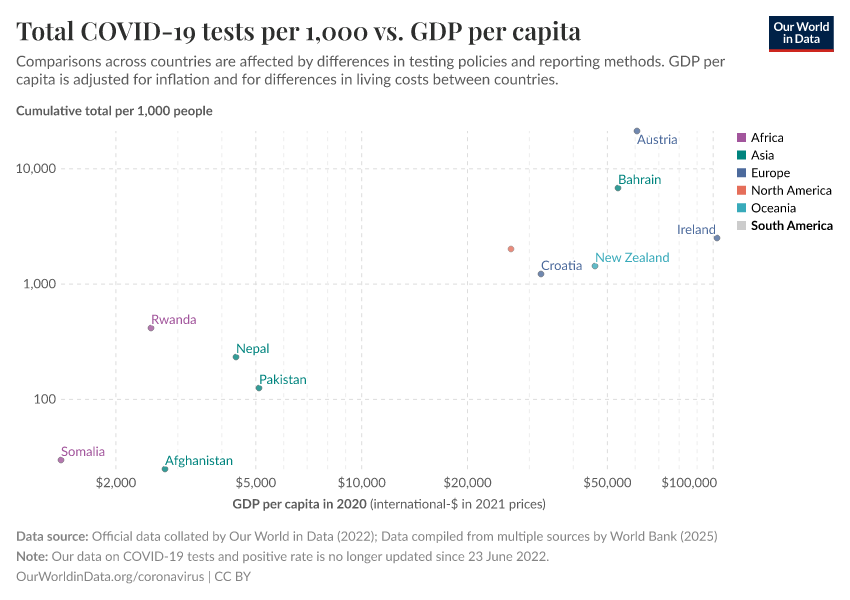Coronavirus (COVID-19) Testing
This article is outdated
The data presented on this page has not been updated since June 23, 2022. You can find our coronavirus testing dataset published in Nature Scientific Data, as well as a web archive of the previous page online.
Testing for COVID-19
This page focuses on testing for COVID-19 and presents data on the levels of testing, the share of tests that are positive, testing policies around the world, and the importance of testing.
Related articles:
- The Our World in Data COVID-19 Testing dataset has been published in the academic journal, Nature
- Best practices for governments reporting COVID-19 testing data
- Ending our COVID-19 testing data updates
The positive rate
Here we show the share of reported tests that returned a positive result – known as the positive rate.
The positive rate can be a good metric for how adequately countries are testing because it can indicate the level of testing relative to the size of the outbreak.
To be able to properly monitor and control the spread of the virus, countries with more widespread outbreaks need to do more testing.
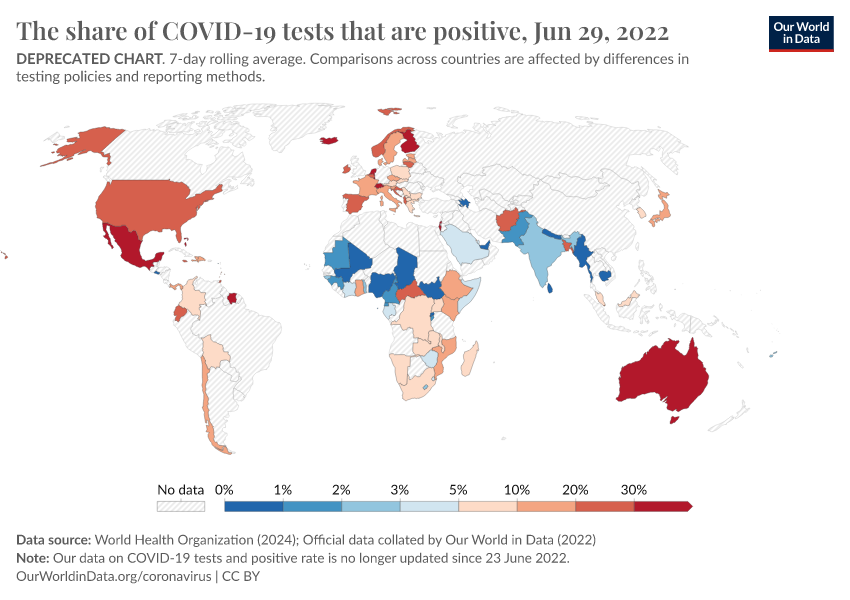
Tests per confirmed case
Another way to look at the level of testing relative to the scale of the outbreak is to ask: How many tests does a country conduct to find one COVID-19 case?
It is simply the inverse of the data on the positive rate.
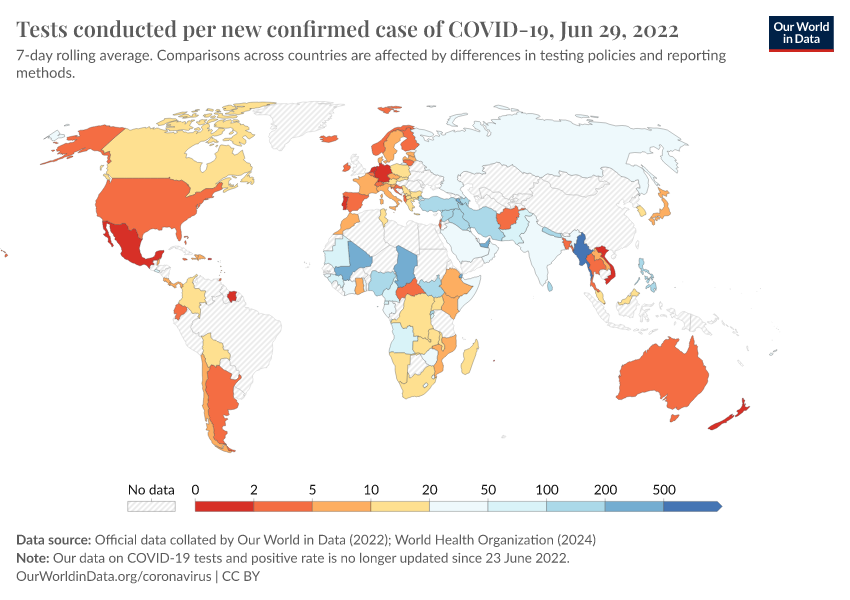
The scale of testing compared to the scale of the outbreak
This scatter chart provides another way to look at the level of testing relative to the scale of the outbreak in different countries.
It shows the daily number of tests (vertical axis) against the daily number of new confirmed cases (horizontal axis), per million people.

Related charts:
How many tests are performed each day?
This chart shows the number of daily tests per thousand people. Because the number of tests often fluctuates day to day, regardless of the underlying level of cases, we show the figures as a seven-day rolling average.
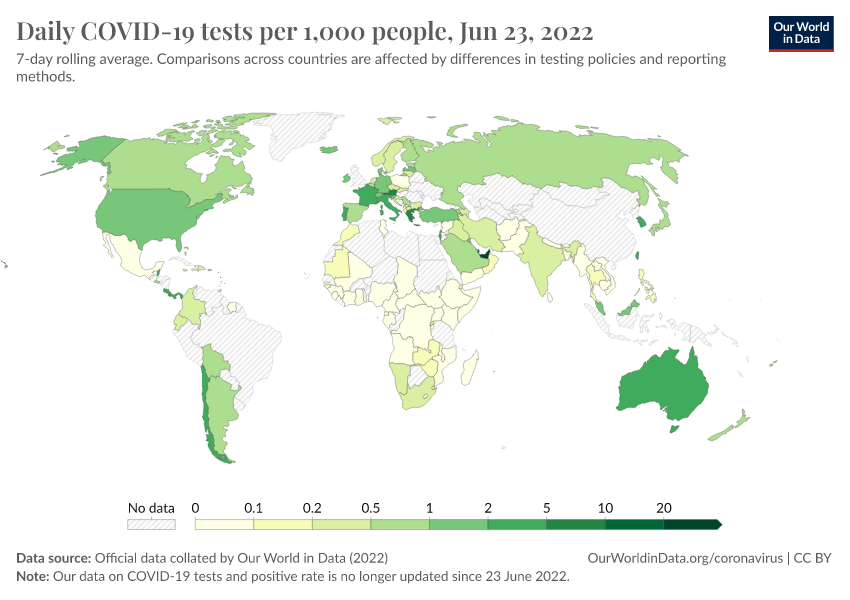
Related chart:
What is counted as a test?
The number of tests is not necessarily measured in the same way in different countries.
For example, some countries report the number of people tested, while others report the number of tests performed (which can be higher if the same person is tested more than once).
Another example is that some countries report their testing data in a way that leaves it unclear what the test count refers to exactly.
We indicate the differences in the chart and explain them in detail in our accompanying source descriptions on GitHub.
World map: total tests performed relative to the size of the population
This map shows you how the total number of tests per thousand people compares across all countries in our dataset.
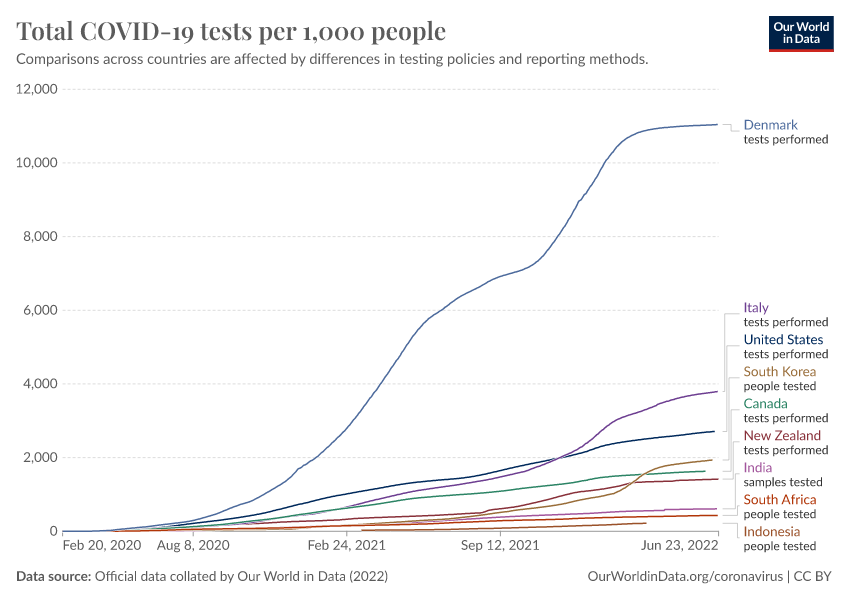
Related charts:
Testing and contact tracing policy
These two maps show testing and contact tracing policies over time, using data from the Coronavirus Government Response Tracker (OxCGRT) produced by researchers at the Blavatnik School of Government, University of Oxford.
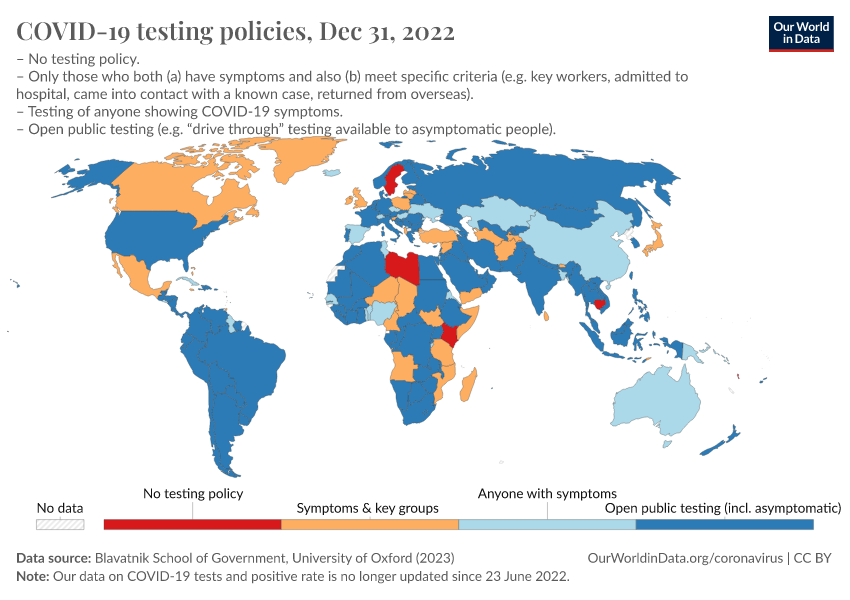
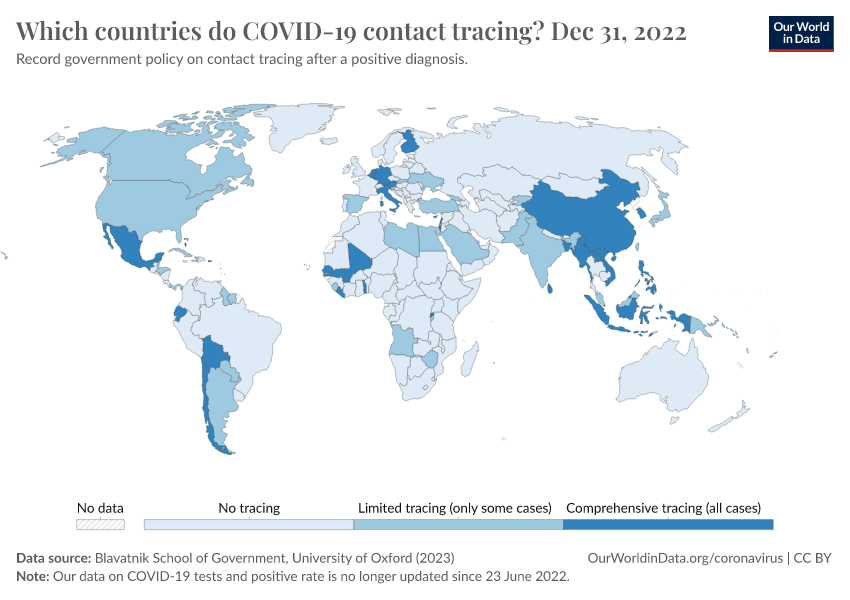
Testing for COVID-19: background
The importance of testing
Testing has been our window into the pandemic and how it is spreading. Without testing, our understanding of the pandemic is limited.
It is one of our most important tools in the fight to slow and reduce the spread and impact of the virus. Tests allow us to identify infected individuals, guiding the medical treatment that they receive. It enables the isolation of those infected and the tracing and quarantining of their contacts.1 It can help allocate medical resources and staff more efficiently.2
In addition, testing for COVID-19 also informs our understanding of the pandemic and the risks it poses in different populations.
This knowledge is important to properly assess the interventions that should be implemented, including very costly interventions such as social distancing and the shutdown of entire regions and industries.
Different types of tests for COVID-19
There are many technologies for COVID-19 testing, some currently available and some still in development.
Broadly, we can divide them into two types of tests:
- Tests for the presence of the virus (including PCR and antigen tests). These aim to establish whether someone is currently infected. The most common way of performing a test of the first type is with a polymerase chain reaction (PCR) test.3 Rapid antigen tests have also become commonly used in many countries, especially for mass testing.
- Tests for past infections (including antibody tests). These aim to establish whether someone has been infected so far. Circulating antibodies wane over time, so test results may be falsely negative if the person was infected several months or years ago.
Currently, we aim to include only PCR and antigen tests in our testing dataset, as our focus is on using testing data to interpret data on confirmed cases and deaths.
Case confirmation is generally based on a positive result from a PCR and/or antigen test, so including antibody tests in our figures would make them less useful for this purpose.
At-home self-tests are widely available in many countries, and may be included if they are reported nationally.
Typically, testing figures only include laboratory tests, and positive laboratory tests are usually still required to confirm cases of COVID-19; the interpretation of the positive rate could therefore be affected.
Our work belongs to everyone
Download the complete Our World in Data COVID-19 dataset
- All our code is open-source
- All our research and visualizations are free for everyone to use for all purposes
Endnotes
Hellewell et al. (2020) discuss factors that influence the success of isolation, testing, and contact tracing on COVID-19 outbreaks. Hellewell et al. ‘Feasibility of controlling COVID-19 outbreaks by isolation of cases and contacts’, The Lancet Global Health, volume 8, issue 4. Available here.
As described by health researchers in this article in The Atlantic.
Here you can find a video that explains how this kind of test works.
Cite this work
This content is outdated, but if you would still like to use it, here is how to cite it:
Our articles and data visualizations rely on work from many different people and organizations. When citing this article, please also cite the underlying data sources. This article can be cited as:
Edouard Mathieu, Hannah Ritchie, Lucas Rodés-Guirao, Cameron Appel, Daniel Gavrilov, Charlie Giattino, Joe Hasell, Bobbie Macdonald, Saloni Dattani, Diana Beltekian, Esteban Ortiz-Ospina, and Max Roser (2020) - “Coronavirus (COVID-19) Testing” Published online at OurWorldinData.org. Retrieved from: 'https://archive.ourworldindata.org/20260105-063300/coronavirus-testing.html' [Online Resource] (archived on January 5, 2026).BibTeX citation
@article{owid-coronavirus-testing,
author = {Edouard Mathieu and Hannah Ritchie and Lucas Rodés-Guirao and Cameron Appel and Daniel Gavrilov and Charlie Giattino and Joe Hasell and Bobbie Macdonald and Saloni Dattani and Diana Beltekian and Esteban Ortiz-Ospina and Max Roser},
title = {Coronavirus (COVID-19) Testing},
journal = {Our World in Data},
year = {2020},
note = {https://archive.ourworldindata.org/20260105-063300/coronavirus-testing.html}
}All visualizations, data, and code produced by Our World in Data are completely open access under the Creative Commons BY license. You have the permission to use, distribute, and reproduce these in any medium, provided the source and authors are credited.
The data produced by third parties and made available by Our World in Data is subject to the license terms from the original third-party authors. We will always indicate the original source of the data in our documentation, so you should always check the license of any such third-party data before use and redistribution.

